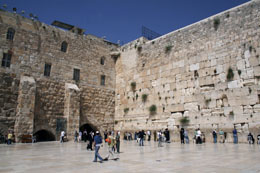WHAT IS YOM YERUSHALAYIM AND WHEN DO WE CELEBRATE IT?
Yom Yerushalayim, Jerusalem Day, falls on 28 Iyar. It commemorates what is, in our era, without doubt the most noble moment in the historic love between Jews and Jerusalem: the liberation of the Old City of Jerusalem and the reunification of all Jerusalem during the Six Day War, on the 28th of Iyar 5727 (1967).

access and pray at the Western Wall, the last remaining part of the Temple complex
which stood in ancient Jerusalem
HISTORICAL BACKGROUND
Jerusalem has always been regarded as a special place in Judaism. The Temple, the holiest site in Judaism and the place where Jews could best commune with God (since it was and is believed that God chose Jerusalem as His special ‘resting place’), was located there. The Kotel or Western Wall (the only remaining part of the ancient Temple complex) remains the holiest site in Judaism, still in modern times visited and prayed at by hundreds or even thousands of Jews every day. However, Jews were not always able to access this most special site due to the whims and decrees of whichever power happened to rule over the land at the time. In 1948 the State of Israel was established, but Eastern Jerusalem (including the Old City of Jerusalem and the Kotel) was not part of the State but instead was ruled over by Jordan, a neighbouring Arab country. Despite assurances to the contrary, Jews were not allowed to visit the Kotel during the period of Jordanian rule from 1948 to 1967.
The above video gives a very brief overview of Jerusalem’s very eventful history
In 1967, on 5th of June (28 Iyar 5727), nineteen years after the establishment of the State of Israel, the surrounding Arab leaders set out (again) to destroy Israel and sent forces to the north, east and south. In addition to this, Egypt blockaded the Straits of Tiran, preventing Israel from using the port of Eilat.
The Israeli Defense Forces (IDF) protected the Land of Israel, and in a war that lasted 6 days, they destroyed the enemies in The Sinai Desert, Golan Heights, Judea and Samaria. The highlight of this victory was the capture of The Old City of Jerusalem including the Temple Mount where the Kotel (‘Western’ or ‘Wailing’ Wall, the last remaining part of the ancient Temple in Jerusalem) stands. Previously this had been in Arab East Jerusalem under Jordanian rule and Jews had not been allowed to visit it.
When the war broke out in the Sinai, it did not seem that Jerusalem, the Holy City, would be involved. But a few short hours after the outbreak of the war, the Kingdom of Jordan, which since 1948 had occupied the Old City, began to shell houses in the Jewish New City.
At first, Israel did not respond to the Jordanian shelling. But as the hours passed, the shelling increased in its intensity. Then the forces of the Jordanian army invaded and took possession of Government House, the headquarters of the United Nations Truce Supervision Organisation.
Faced with a serious Jordanian offensive threatening New Jerusalem and the lives of its inhabitants, the IDF moved against Jordan. Thus, unexpectedly, Jerusalem became not only a part of the war, but actually its focus.
After two days of heroic battle, the IDF entered the Old City through the Lions’ Gate, and marched to the Western Wall and the Temple Mount. For 2,000 years after the destruction of the Temple by the Romans, the City of David had been occupied by one foreign power after another. Exiled Jews in every generation pledged in the words of the Psalm (132:5 – 6), “If I forget thee o Jerusalem, let my right hand forget her cunning …. .if I prefer not Jerusalem above my chief joy.”
Jerusalem had not been forgotten: the Jews had returned. For almost 20 years, Jerusalem had been unnaturally divided. Jordan, despite its original promises, had denied Jews access to the Old City, and had desecrated Jewish holy places. Now Jerusalem was united under Israeli control.

The profound significance of the liberation of Jerusalem transcends the military, the political, the nationalistic, and the sentimental. Indeed, the Chief Rabbinate of Israel has ruled that each year, on the 28th Iyar, the Hallel be recited – with the following blessing:
For the liberation of Jerusalem carries with it the hope that the prophetic vision of Jerusalem shall soon be realised. This is the sacred vision of true peace and true love, the most sublime vision of mankind. It is the vision expressed in the words of Isaiah (2:1 – 5): The mountain of the House of the Lord shall be established…and all the nations shall flow to it, and many people shall come and say: “Let us go to the mountain of the Lord…that He may teach us His ways…” For out of Zion shall go forth the Torah, and the word of the Lord from Jerusalem….And they shall beat their swords into plowshares, and their spears into pruning hooks; nation shall not lift up sword against nation, neither shall they learn war any more.
HOW DO WE CELEBRATE YOM YERUSHALAYIM?
On Yom Yerushalayim special prayers and readings are said in synagogues around the world. In Israel, there are national ceremonies (especially at the Western Wall and Ammunition Hill). There is a march through the City of Jerusalem and places of entertainment around Israel’s city centres.
LINKS
Aish: Why Celebrate Jerusalem Day?
Aish: Why Jerusalem Matters
Aish: How Nachmanides Rebuilt Jerusalem
Jewish Virtual Library: Jerusalem – An Introduction
Youtube: IDF Soldiers Liberate the Old City of Jerusalem [IDF = Israel Defense Forces]


